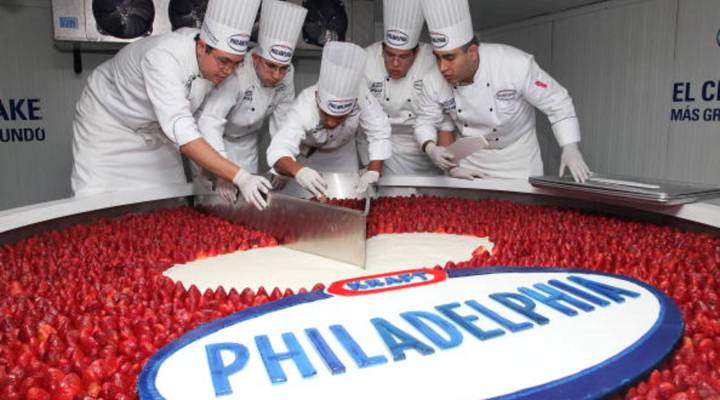
Cream cheese has a history wrapped in tin foil

This is just one of the stories from our “I’ve Always Wondered” series, where we tackle all of your questions about the world of business, no matter how big or small. Ever wondered if recycling is worth it? Or how store brands stack up against name brands? Check out more from the series here.
Listener Steven Yancey sent in this question:
Why does cream cheese come in packaging that is so difficult to reuse?
Venture to the nearest supermarket and there is a chance that the cream cheese stocked on its shelves comes wrapped in tin foil and a thin cardboard box. Turns out Philadelphia Cream Cheese — the global brand of cream cheese made by Kraft — has been wrapped in tin foil for more than dozen decades.
“We still use foil for our brick Philadelphia Cream Cheese,” said Lynne Galia, a Kraft spokeswoman told Marketplace. “Foil provides a strong light and oxygen barrier for our product, limiting oxidation, which helps maintain the great taste and quality of our Philadelphia Cream Cheese. High quality Philadelphia Cream Cheese has been made, wrapped in foil, since the late 1800s. While we don’t have details on the origin of the brick shape, it certainly makes sense to package this dairy product in foil.”
Kraft does sell cream cheese in plastic tubs; some U.S. supermarkets carry both packagings. Typically, flavored cream cheese comes in a plastic tub while the plain classic cream cheese is most often found wrapped in a foil. The plastic containers are easier to reuse after opening than the tin foil packaging.
In the United Kingdom, Philadelphia Cream Cheese is only sold in plastic containers. The company’s global arm, which is now a separate company known as Mondelez, only sold cream cheese in tin foil between the 1960s and 1980s. On the history page of its U.K. website, the cream cheese manufacturer notes that between the years 1977 and 1985, new packaging was introduced along with new flavored and low fat cream cheeses.
“The fiddly foil packages are replaced with a handy tub,” according to the site.
To find out why cream cheese was packaged in foil in the first place, Marketplace reached out to Jeff Marx, a rabbi and a cream cheese expert.
“Cream cheese is a very soft cheese. It has to be wrapped for it to maintain some type of form,” explained Marx. Back in 1877, William Lawrence was manufacturing cream cheese at his farm in Chester, New York. To wrap his cheese, he used 3-by-4 inch square-like forms and manila tissue paper that Marx described as a firm piece of paper.
| Kraft tries out cream cheese on JetBlue |
| Company seeks American cheese ‘revolution’ |
“Up to this time, almost all cheese was produced in round hoops, but when you are packing smaller cheeses in a box to ship them, you can pack more cheeses in square form than in a round form. This is one of the key moments in manufacturing where product’s shape changes for various production reasons.”
In 1880, Lawrence was approached by Alvah Reynolds, who wanted to distribute the cream cheese produced by Lawrence.
“Reynolds is a marketing genius. He says to Lawrence: ‘You need a name for your cheese.’ Because up till now, you just got a cheese in a box that says ‘sold by Lawrence.’ So Reynolds says, ‘Let’s give it a name.’ And he says: ‘Look, Philadelphia has a reputation for fine cheeses. It has for a long period of time. Let’s call it a Philadelphia cheese, and let’s put the name on the cheese wrappers,” Marx said. Reynolds also suggested that they use tin foil, which would be easier to imprint. The two men do exactly that. “And from then on, Philadelphia’s cream cheese has this signature form wrapped in tin foil with Philadelphia cream cheese printed on the top.”
There’s a lot happening in the world. Through it all, Marketplace is here for you.
You rely on Marketplace to break down the world’s events and tell you how it affects you in a fact-based, approachable way. We rely on your financial support to keep making that possible.
Your donation today powers the independent journalism that you rely on. For just $5/month, you can help sustain Marketplace so we can keep reporting on the things that matter to you.












